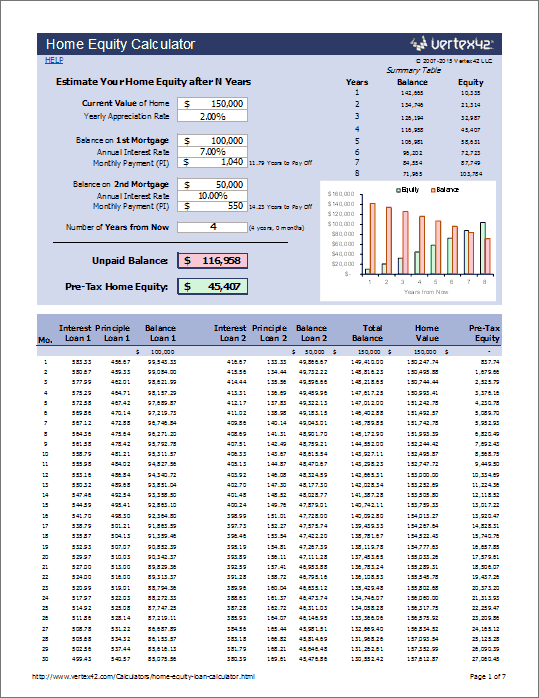Table of Content
Another way to increase your score is to pay down high-balance accounts. You decrease your credit utilization ratio by paying them down, which shows you have more credit available to you and aren't, for example, maxed out on your credit cards. Another way to reduce your credit utilization is to request a credit line increase—the more space you put between your debt and your credit limit, the better. Home equity loans and HELOCs are both technically second mortgages on your home. BMO offers home equity loans from five to 20 years, with loan amounts starting at $5,000. While there are no closing costs, if you pay your loan in full within 36 months, you may incur a fee for the bank to cover the costs of closing the loan initially.

If you’re self-employed, you’ll have to provide your federal income tax returns for the last two years. If you receive retirement income, the lender will want to see a retirement award letter or 401 distribution letter. You’ll want to produce a solid estimate of the home’s value, as well as documents showing your household income, Social Security number and any other outstanding balances. Lenders also will ask for a mortgage statement, a property tax bill and a copy of your homeowner’s insurance policy, among other requested documents. The five Cs of credit are character, capacity, collateral, capital, and conditions.
How to Use the Home Equity Loan Calculator
The downside to this is that interest rates may increase and you could get stuck paying rates while still having to make your regular mortgage payment simultaneously,” says Eberts. That has implications for the Federal Reserve’s efforts to bring price growth down, but it also means a lot for consumers, especially those looking to borrow money. The Fed will likely continue to raise its benchmark interest rate – the federal funds rate – in its ongoing bid to stem demand and lower inflation. But that rate affects the cost to borrow money across the economy, particularly home equity lines of credit or HELOCs.

This includes performing a hard pull of your credit report and requiring proof of your income. This has many homeowners — maybe you — asking whether the time is right to access the cash you have tied up in your home. If you are unsure how much equity you want to borrow, consider applying for a home equity line of credit instead.
What Is the Best Way to Get Equity Out of Your Home?
In the above example, if your loan balance is $200,000 and your home is appraised at $300,000, divide the balance by the appraisal and you get 0.67, or 67%. Therefore, your LTV is 67%, which means you have 33% of equity in your home. If you end up needing more money than what you borrowed with a home equity loan, you’ll have to apply for another loan.

HELOCs often have variable interest rates that are directly tied to an index – the prime rate – that moves in lockstep with the federal funds rate. A HELOC is one of the best ways to get equity out of your home. To leverage your equity, you first need to build equity in your home. You build up equity by making a down payment and paying down the principal balance on your mortgage. Good credit opens many doors, especially in the world of lending.
Best For Lowest Starting Rate
A lender will consider a co-signer’s or co-borrower’s income if you have one. That way, you could potentially meet the DTI requirements to qualify for a home equity loan or HELOC without a job. Before you apply, reach out to the lender to see what income sources are acceptable. When deciding whether to issue loans, lenders want to make sure that they’re not taking on too much risk. One of the main ways to do this is to evaluate potential borrowers’ payment history. Bankrate’s editorial team writes on behalf of YOU – the reader.
After you have used the funds to pay this off, you’ll have the remainder—minus any closing costs—to use how you see fit. However, every loan will factor into the requirements for a new loan, as lenders use the combined loan-to-value ratio . The CLTV is calculated by deducting your home value from all existing loans, including your primary mortgage, other home equity loans, and home equity lines of credit. Thus, the amount you can borrow will be diminished with each new loan. If you’re looking for a relatively short-term loan, a 0% APR credit card may be a good option. These credit cards charge zero interest for an introductory period, but the interest rate jumps back to a normal rate after that time.
Depending on the size of your loan, you may encounter several fees to take out an RBFCU home equity product. Researching a lender’s products, services, and company history is an important first step. Next, it’s wise to see what customers say about their own experiences with the company. We make no representation as to the completeness or accuracy of information provided on Linked Sites. When you access a Linked Site, you assume total responsibility and risk for your access and use of such Linked Site. Enjoy the everyday convenience of a credit card while saving on interest.
You hire the contractor and draw funds from the HELOC as needed to pay for the work. Your minimum payments during the draw period are interest only . Once the draw period ends, you pay both interest and principal. Your eligibility and personalized interest rate will be based on how well you meet a lender’s requirements. For instance, a higher credit score and lower DTI ratio should get you more favorable terms.
Editorial content from NextAdvisor is separate from TIME editorial content and is created by a different team of writers and editors. “Equity is the difference between the home’s appraised value and the total mortgage balance,” says Samuel Eberts, junior partner and financial advisor with Dugan Brown, a retirement firm. To borrow from your home’s equity, you need to have enough equity in your home. To qualify, you should have already paid down at least 15% to 20% of your home’s value — so, for example, $100,000 if your home is valued at $500,000. Part of this process will be the lender appraising your home’s value, which comes at your expense.
Be careful that you don’t borrow more money — and use up more of your equity — than you think you’ll need. You want to make sure you can pay back the loan, since you’re using your home as collateral. Additionally, keep in mind your home price may decrease, causing the equity in your home to decrease, and you could wind up upside down on your mortgage. Both home equity loans and cash-out refinancing allow homeowners to tap into the equity in their homes. However, while a home equity loan is taken on in addition to your original mortgage, a cash-out refinance loan replaces your existing mortgage with a larger one. It allows you to take the difference between the new mortgage balance and old mortgage balance in cash and use it as you wish.
Compare rates and payments for a variety of home equity options. Your mortgage payment is a combination of principal and interest payments. Your primary mortgage provider will detail how much you’ve paid in principal on your mortgage statements. Improve your Credit Score - As with any loan, you will need to have a certain credit score in order to qualify.

We have since expanded to operate statewide as a full-service financial institution and have more than 44 financial centers. We offer our personalized service to individuals, nonprofits and businesses. In addition to home equity loans and HELOCs, our services and solutions include mortgages and checking and savings accounts. If you’d rather not take on a loan that’s secured by your home, consider a personal loan instead.
HELOC rates are tied more closely to banks than are first-mortgage rates, which tend to track the performance of the bond market. For loans up to $175,000, you’ll pay no appraisal or application fees. You can expect to pay higher upfront costs for loans over $175,000. RBFCU will disclose the exact amounts during the underwriting process. Interest rates are often variable, increasing or decreasing over time. Your minimum payment due depends on your interest rate and outstanding balance.


No comments:
Post a Comment